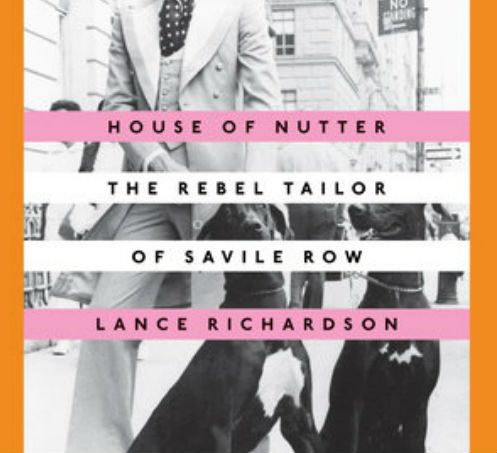‘House of Nutter: The Rebel Tailor of Savile Row’ by Lance Richardson

Author: Tom Cardamone
August 6, 2018
The rock ‘n’ roll spirit–imported by Britain in the 50s and 60s and made that country’s own—infuses every page of House of Nutter: The Rebel Tailor of Savile Row. The Beatles, the Stones, and Elton John, all dance through this delightful and compelling book, and though they’re the music makers here, all were styled by Tommy Nutter. Nutter, the book shows, cut the vibrant cloth of the zeitgeist.
From the Beatles’ suits for the iconic Abbey Road album cover (except George, in jeans of course), to the bespoke beauties worn by the flamboyant-yet-then-publicly-closeted Elton John, Tommy Nutter came of age during the age of great change. He shook up men’s fashion while jet-setting with the in-crowd. But House of Nutter is very much a story of brothers. David Nutter, just a few years older, was also gay. Through the bond they formed over fashion and musicals, they vaulted over their predestined working class jobs and toward futures of their own design.
Tommy conquered Savile Row, London’s storied street of elite tailor shops. As a photographer, David moved in all the right circles, eventually landing in New York City. Their separation launched a lengthy correspondence between brothers that David dutifully preserved: a record of an era whose queer influences are not overtly recognized, though individual contributions get their compartmentalized due, to a point.
The young Tommy Nutter comes across as a good-looking guy with taste and a penchant for occasionally outrageous behavior, who happened to be in the right place at the right time. But he made finding the right place at the right time an art-form of its own, excelling at socializing as well as designing. Tommy dated Peter Brown, best friend and assistant to Brian Epstein, the Beatles’ manager (Brown took on the role after Epstein’s untimely death). This gave him entrée into the counterculture elite just as his own career and business were taking off. With funding from famous backers, Tommy opened Nutters of Savile Row and promptly blew the doors off what had previously been a stuffy, conservative industry. An instant hit, garnering press galore, the shop fitted everyone, from the glitterati to businessmen. From an American customer:
“How can I say this? It made me feel that I was really dressed. Like I was a piece of art.”
Peter Brown decamped to New York City after the Beatles broke up, a dissolution that David captured on film as his reputation as a photographer grew. He traveled with John and Yoko to photograph their marriage in Gibraltar and found himself in the Big Apple headquarters in the band’s final days. The allure of New York had always been strong (both brothers obsessed over West Side Story in their youth) so David gave it a go, hooking up with Elton John’s entourage and indulging in the emerging downtown club scene.
Not that life was idyllic for either brother. In London, Tommy lost the business but was able to regain his footing by working at an established house hungry for new talent. Depression, drugs, and traveling within the dramatic orbit of a rock superstar took its toll on David. But as both brothers moved into the 1980s, each secured success. Tommy dressed Bianca Jagger and the like, continuing to innovate, he even designed suits for the Joker in Tim Burton’s Batman film. (His clothes have subsequently been collected at the Metropolitan and Victoria and Albert Museums.) David published his photographs of Elton John on tour in a book.
Yet no matter how many times you’ve read about gay life in the second half of the prior century, with foreknowledge that the specter of AIDS looms as large and dark as anything ever on the horizon, when it hits, it still startles and destroys in a way both familiar yet freshly devastating. As the first deaths are reported, David falls perilously ill with what turns out to be hepatitis. This and a horrific assault and robbery made him much more circumspect, prolonging his life and making this book possible. A decade later, Tommy finds a dark spot on his ankle, what will turn out to be Kaposi’s sarcoma. In writing about Tommy’s illness and passing, writer Lance Richardson deserves the highest possible praise for his revealing compassion. So much has been written, so much has been lost, that the importance of getting it “right,” so to speak, cannot be understated.
For anyone looking to capture history, the lesson of House of Nutter is a simple one: act now. We are blessed to be in the presence of many of our fore-figures, those original rebels, the ones who made it happen in every conceivable way. Prior generations of gay activists, agents, artists, athletes, architects, athletes, authors, conductors, designers, DJs, doctors, filmmakers, journalists, lawyers, musicians, nurses, painters, playwrights, poets, politicians, publishers, researchers, sculptors, singers, and teachers have great stories, many untold, waiting for someone to reach out, and connect.
House of Nutter: The Rebel Tailor of Savile Row
By Lance Richardson
Crown Archetype
Hardcover, 9780451496461, 400 pp.
May 2018

